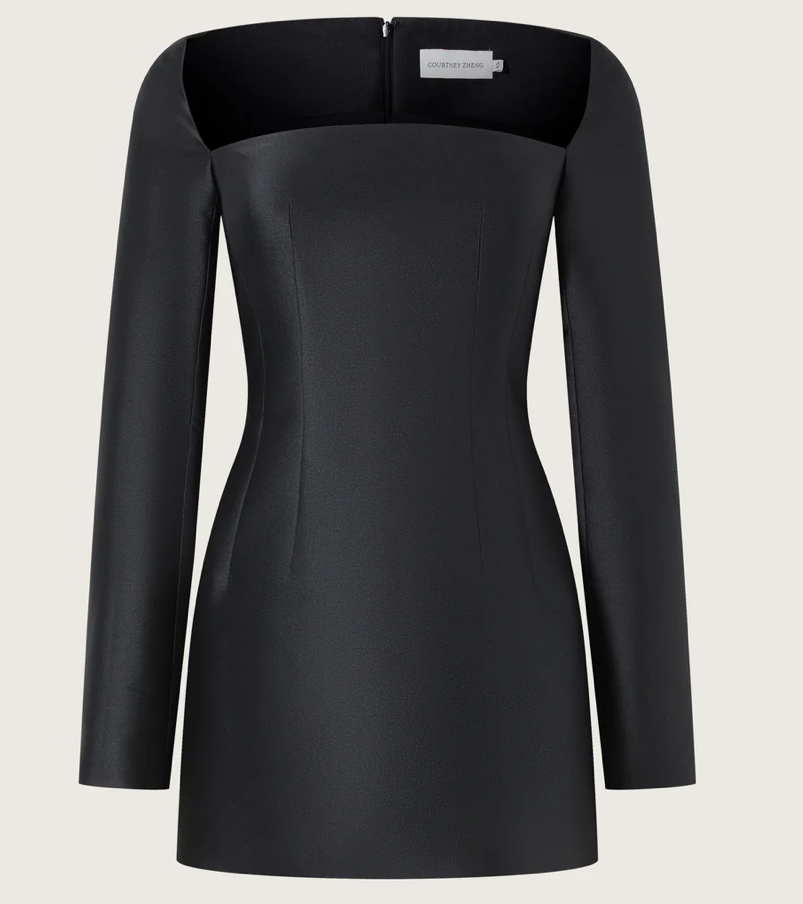In the ever-swirling currents of contemporary fashion, where the conceptual often dominates the wearable, the Blythe Silk Dupion Mini Dress by Courtney Zheng arrives as a rare equilibrium—neither overwrought nor underdone, it is instead a garment of sharp control, distilled elegance, and restrained audacity. This dress doesn’t scream; it knows the value of a whisper. It walks into a room the way moonlight spills across a marble floor: confident, poised, and unfazed by passing trends.
For Courtney Zheng—a designer whose pieces live in the tension between structure and softness—the Blythe mini dress stands as a thesis in architectural tailoring, textile finesse, and quiet drama. The use of silk dupion, a fabric known for its crisp texture and luminous irregularities, is more than a material choice. It’s a philosophical declaration: beauty exists in contrast, in texture, in the offbeat shimmer that only natural fibers can provide.
What follows is a comprehensive exploration of this singular dress—from its sculptural silhouette to its historical echoes, from Zheng’s personal design ethos to its place within a fashion world increasingly obsessed with emotional precision.
The Shape of Intention: Architectural Clarity in a Miniature Frame
At its core, the Blythe Mini Dress is built like a relic of futurist couture. With its puffed sleeves, sharply cut waist, and flirtatiously abbreviated hem, the garment recalls a sense of regality and rebellion—Marie Antoinette imagined through the lens of Helmut Newton.
The silhouette clings only where it matters. It cinches at the torso with the delicacy of origami, structuring the body into sculptural curves rather than romantic drapes. The mini-length hemline provides contrast: it’s playful, irreverent, even flirtatious. But the balance remains impeccable. Each element—the fullness of the sleeve, the sculpted bodice, the clean fall of the skirt—is a counterpoint to the next.
If fashion is a language, this dress speaks in a dialect that blends modernist rigor with baroque punctuation. There’s tension in its construction: the sleeves hover with volume while the body pulls taut. There’s discipline in the proportions: nothing excessive, nothing wasted. Zheng has not so much designed a dress as she has engineered one.
The Material Speaks: Why Silk Dupion Matters
Silk dupion is a fabric born from irregularity. Harvested when two silkworms spin closely together, it results in a slubby, textural weave that shimmers unevenly under light. Designers typically treat this material with reverence, often giving it space to breathe in gowns or formal wear. But Zheng’s decision to cut a mini dress from this fabric is both subversive and illuminating.
In the Blythe dress, silk dupion becomes a skin of sophistication. Its innate stiffness allows the garment to hold form with minimal internal structure. Its luster, never garish, changes depending on the angle of the wearer and the light. Each fold reflects with the intimacy of candlelight and the cold logic of neon. Here, the material functions not just as fabric but as atmosphere—a kind of kinetic texture that turns the dress into a living, shimmering sculpture.
The raw edges are invisible. The seaming is architectural. The interior is as beautiful as the exterior—an unspoken rule in couture that Zheng clearly understands. The result is a dress that doesn’t rely on prints, embellishments, or embroidery. Its richness is embedded in its very weave.
Courtney Zheng: The Designer’s Language
For the uninitiated, Courtney Zheng is not merely a fashion designer—she is an orchestrator of moods, a choreographer of silence and texture. Her training in both design and fine arts informs a body of work that often sits at the intersection of visual minimalism and tactile maximalism.
She’s not interested in fleeting novelty. Zheng’s garments, including the Blythe, favor timeless eccentricity—pieces that feel fresh today but would be equally arresting in a 1997 editorial or a 2045 runway archive. Her work resists direct categorization. Instead, she builds what might best be described as emotional armor—clothing that fortifies the self while inviting intimacy from others.
The Blythe Silk Dupion Mini Dress is a distillation of this philosophy. It protects as much as it reveals. It outlines the body without rendering it exposed. The voluminous sleeves are both ornamental and strategic—a declaration of presence, a refusal to shrink.
Zheng understands that the modern woman must be multiple things at once: structured yet fluid, poised yet unbothered, soft in fabric yet commanding in form. This dress answers that call with quiet confidence.
Cultural Significance: Between Fantasy and Function
To wear the Blythe dress is to engage in a kind of symbolic play. It’s a fantasy item, yes—born of couture dreams and editorial aspiration—but it is also startlingly wearable. Zheng’s genius lies in her ability to compress a sense of theatre into a dress that can be zipped up in moments and worn without assistance.
Unlike most mini dresses on the luxury market, Blythe does not rely on overt sex appeal. It’s a study in power, not provocation. The shorter length doesn’t scream clubwear; it murmurs modernity. The silk dupion isn’t just fancy—it’s tactical. And the sleeves aren’t whimsical—they’re intentional, sculpted to frame the body like parentheses around a central idea.
In a cultural moment when women’s fashion is often either too coy or too combative, the Blythe finds rare neutrality. It neither begs for attention nor denies it. It makes the wearer feel like they belong to another, more refined realm—one where elegance is subversive, and softness is a strength.
The Wardrobe Implication: Legacy in the Closet
The Blythe Silk Dupion Mini Dress isn’t merely a special occasion piece; it’s a dress with staying power. Styled with a pair of square-toe flats and a rigid handbag, it leans into contemporary editorialism. Worn with heels and no accessories, it channels minimalist couture. Paired with knee-high boots and an oversized trench, it transforms into a kind of wearable contradiction—romantic yet tactical.
It’s this mutability that grants it legacy status. The dress resists being typecast. It doesn’t require a specific season or social event. It travels well. It photographs immaculately. It holds its shape after multiple wears, thanks to the resilience of dupion silk.
One could imagine it becoming a signature garment in a capsule wardrobe—a kind of black swan in a sea of utilitarian basics. Its boldness lies not in loudness, but in the depth of its execution.
Fashion as Language: The Blythe as a Sentence
In literary terms, the Blythe dress reads like a well-punctuated sentence. The volume of the sleeves is the comma that offers breath. The cinched waist is the verb—the action. The hemline is the period: crisp, final, declarative. When worn, the dress completes its thought.
This is where Zheng’s work excels—transcending fashion-as-object and entering the realm of fashion-as-language. Each element of construction speaks. Each fold communicates. And yet, it remains silent enough to let the wearer speak louder. That balance—between garment and self—is the hallmark of great design.
A Future Classic
There’s a reason pieces like this don’t often appear in fast fashion. The Blythe dress takes time. Time to source the right fabric. Time to sculpt the pattern. Time to perfect the fit on diverse body types. Courtney Zheng doesn’t compromise on those stages—and the result is a garment that feels like the opposite of disposable.
Where many dresses fade with the season, this one builds memory. It feels like something one might inherit, like a jewelry box filled with old perfume. It belongs to weddings, to art openings, to nights when you walk home alone and feel invincible.
In this way, it carves out space for a new kind of flow—one that doesn’t rely on logos or lineage, but on meaning and craft.
Flow
Courtney Zheng’s Blythe Silk Dupion Mini Dress is more than a designer garment. It is a poetic object. A structural study in femininity. A challenge to the industry’s obsession with spectacle. With its disciplined lines, luminous materiality, and near-literary structure, the dress emerges not just as a product, but as a story—told in seams, in light, in breath.
In a marketplace saturated with transient beauty and algorithm-approved trends, the Blythe dress reminds us that fashion still has the power to pause. To demand nothing more than attention. To offer presence instead of performance.
And in that pause—where silk meets skin, where structure meets softness—we find not just a dress, but a possibility. A future of fashion that whispers, and is heard.
No comments yet.









